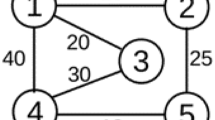Abstract
The cloud offers more services across multiple infrastructures and rapidly growing areas of development in medical care. In the cloud, Network virtualization allows multiple isolated virtual networks (VNs) for flexible sharing of network resources. The virtual network mapping in Network virtualization provides the dynamic virtual node and link resources to satisfy the user needs. The major challenges of cloud computing are optimally and resourcefully responds to each user service requests with minimum time. To address these problems in distributed and hybrid cloud environments, Multicriteria Dragonfly based Graph Theory Resource Optimized Virtual Network Mapping (MD-GTROVNM) technique is introduced. The main objective of the MD-GTROVNM technique is to improve the efficiency of virtual network request mapping with less resource utilization. In the MD-GTROVNM technique, Multicriteria Dragonfly based Graph Theory performs both virtual node mapping and link mapping with reasonable resource utilization such as CPU, memory, and bandwidth. In node mapping, the Multicriteria Dragonfly optimization technique is applied to find the optimal physical node among the population that satisfies the resource constraints. The proposed Multicriteria Dragonfly optimization algorithm achieved a more optimal solution for virtual network mapping. The experimental scenario is carried out with various parameters such as mapping efficiency, computation time, Request acceptance ratio and memory consumption with a number of VN requests. The observed results confirm that the MD-GTROVNM technique effectively increases the mapping efficiency, Request acceptance ratio and minimizes the computation time as well as memory consumption when compared to the existing techniques.







Similar content being viewed by others
References
Zheng X, Tian J, Xiao X, Cui X, Yu X (2019) A heuristic survivable virtual network mapping algorithm. Soft Comp, Springer 23(5):1453–1146
Xing H, Zhou X, Wang X, Luo S, Dai P, Li K, Yang H (2019) An integer encoding grey wolf optimizer for virtual network function placement. Appl Soft Comput 76:575–594
Alhazmi K, Sharkh MA, Shami A (2018) Drawing the cloud map: virtual network provisioning in distributed cloud computing data centers. IEEE Syst J 12(2):1480–1491
Rongzhen Lee, Qingbo Wu, Yusong Tan, unyang Zhang (2018) On the optimal approach of survivable virtual network embedding in virtualized SDN, IEICE Trans Inf Syst, 101, 3, 698–708
Li D, Hong P, KaipingXue JP (2019) Virtual network function placement and resource optimization in NFV and edge computing enabled networks. Comput Netw, Elsevier 152:12–24
Yuan Y, Wang C, Peng S, Sood K (2018) Topology-oriented virtual network embedding approach for data centers. IEEE Access 7:2429–2438
Xiao X, Zheng X, Zhang Y (2017) A multidomain survivable virtual network mapping algorithm. Secur Commun Netw, Hindawi 2017:1–12
Liu X, Wang B (2018) An algorithm for fragment-aware virtual network reconfiguration. PLoS One 13(11):1–16
Gupta L, Jain R, AimanErbad DB (2019) The P-ART framework for placement of virtual network services in a multi-cloud environment. Comput Commun 139:103–122
Inführ J, Raidl G (2016) A memetic algorithm for the virtual network mapping problem. J Heuristics 22(4):475–505
Xu L, Zhang Z, Li X, Sen S (2016) Optimal virtual network embedding based on artificial bee colony. EURASIP J Wirel Commun Netw 273:1–9
Zhang P, Yao H, Qiu C, Liu Y (2018) Virtual network embedding using node multiple metrics based on simplified ELECTRE method. IEEE Access 6:37314–37327
Shahin AA (2015) Virtual network embedding algorithms based on best-fit subgraph detection. Comput Inf Sci 8(1):62–73
Chen T, Liu J, Tang Q, Huang T, Huo R (2019) Virtual network embedding algorithm for location-based identifier allocation. IEEE Access 7:31159–31169
IlhemFajjari NA, Dab B, Pujolle G (2016) Novel adaptive virtual network embedding algorithm for Cloud’s private backbone network. Comput Commun 84:12–24
Alzahrani AS, Shahin AA (2017) Energy-aware virtual network embedding approach for distributed cloud. Int J Adv Comput Sci Appl 8(10):239–246
Jahani A, Khanli LM, Hagh MT, Badamchizadeh MA (2019) EE-CTA: energy efficient, concurrent and topology-aware virtual network embedding as a multi-objective optimization problem. Comput Stand Interfaces 66(2019):1–17
Song A, Chen W-N, Gu T, Yuan H, Kwong S, Zhang J (2019) Distributed virtual network embedding system with historical archives and set-based particle swarm optimization. IEEE Trans Syst Man Cybern: Syst:1–16
Haeri S, Trajković L (2018) Virtual network embedding via Monte Carlo tree search. IEEE Trans Cybern 48(2):510–521
Yao H, Zhang B, Zhang P, Wu S, Jiang C, Guo S (2018) RDAM: a reinforcement learning based dynamic attribute matrix representation for virtual network embedding. IEEE Trans Emerg Top Comput:1–14
Farzai S, Shirvani MH, Rabbani M (2020) Multi-objective communication-aware optimization for virtual machine placement in cloud datacenters. Sustain Comput: Inform Syst 2020:1–47
Li Z, Yu X, Yu L, Guo S, Chang V (2019) Energy-efficient and quality-aware VM consolidation method. Futur Gener Comput Syst 102:789–809
Hmaity A, Savi M, Askari L, Musumeci F, Tornatore M, Pattavina A (2019) Latency- and capacity-aware placement of chained virtual network functions in FMC metro networks. Opt Switch Netw 35(2010):1–28
Author information
Authors and Affiliations
Corresponding author
Ethics declarations
Conflict of interest
We haven’t conflict of interest.
Ethical approval
This article does not contain any studies with human participants or animals performed by any of the authors.
Additional information
Publisher’s note
Springer Nature remains neutral with regard to jurisdictional claims in published maps and institutional affiliations.
Rights and permissions
About this article
Cite this article
Balamurugan, N., Raja, J. & Pitchai, R. Multicriteria dragonfly graph theory based resource optimized virtual network mapping technique for home medical care service provisioning in cloud. Peer-to-Peer Netw. Appl. 13, 1872–1885 (2020). https://doi.org/10.1007/s12083-020-00923-4
Received:
Accepted:
Published:
Issue Date:
DOI: https://doi.org/10.1007/s12083-020-00923-4




